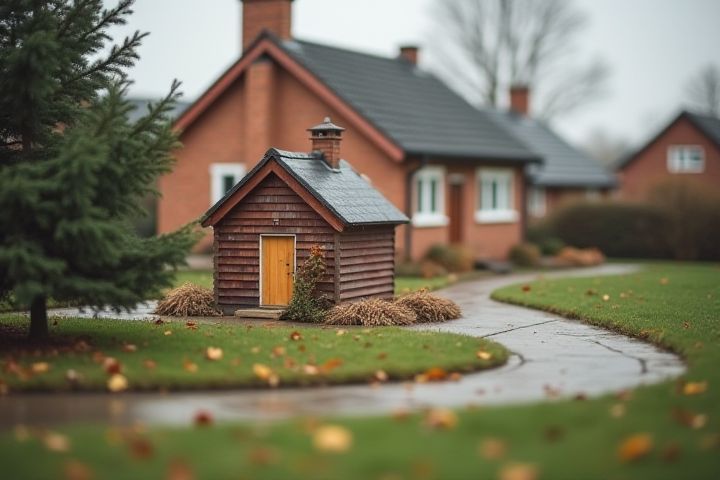
House prices have surged due to a combination of factors, including low mortgage interest rates, increasing demand for homes, and limited housing supply. The COVID-19 pandemic accelerated urban flight, prompting many to seek homes in suburban and rural areas, thus driving up prices. Additionally, remote work has led to shifts in housing preferences, with buyers prioritizing space and amenities. Inflation and rising material costs have further constrained new construction, exacerbating supply shortages. When combined, these elements create a competitive real estate market, significantly impacting house prices.
Why Have House Prices Increased
Low interest rates
Low interest rates have significantly influenced the surge in house prices by making borrowing more affordable, enabling more buyers to enter the market. As mortgage rates decrease, monthly payments become lower, allowing you to purchase a more expensive home without straining your budget. This increased demand for housing often outpaces supply, leading to competitive bidding and ultimately driving prices higher. Furthermore, low interest rates encourage real estate investment, as investors seek to capitalize on rising property values and rental income potential.
Limited housing supply
Limited housing supply plays a significant role in the increase of house prices. In many regions, the construction of new homes has not kept pace with population growth, leading to a deficit in available properties. For instance, studies indicate that the U.S. faces a shortage of approximately 3.8 million homes, which exacerbates competition among buyers. As demand continues to outstrip supply, you may find that rising prices become a daunting challenge in the current housing market.
High demand for housing
High demand for housing is a primary driver behind the increase in house prices, with demand often outpacing supply in many urban areas. In 2023, the National Association of Realtors reported that housing inventory was at a historic low, with fewer than 1 million homes available for sale, leading to intense competition among buyers. Additionally, low mortgage interest rates have further fueled buyer activity, making home purchases more attractive and accessible. As a result, in major cities, home prices surged by approximately 10% over the past year, reflecting the critical interplay between supply constraints and heightened demand.
Government incentives
Government incentives, such as tax credits and grants for first-time homebuyers, have significantly contributed to the rise in house prices. These financial benefits stimulate demand by making homeownership more accessible and appealing, especially among younger buyers. Furthermore, low mortgage interest rates, often a result of government monetary policy, allow individuals to borrow larger sums, driving competition in the housing market. As a result, these factors combined create upward pressure on prices, making homes increasingly expensive over time.
Rising construction costs
Rising construction costs have significantly contributed to the increase in house prices, with materials like lumber and steel experiencing price hikes of over 20% in recent years. Labor shortages in the construction industry have also exacerbated this issue, driving up wages by approximately 10% in many regions. In addition, regulatory changes and supply chain disruptions during the pandemic have further inflated costs, making new housing developments more expensive. As a result, the overall housing market sees a direct correlation between escalating construction expenses and higher prices for buyers.
Urbanization trends
Urbanization has significantly contributed to the rise in house prices, particularly in metropolitan areas where over 55% of the global population resides. The demand for housing in cities is driven by economic opportunities, with job growth often outpacing housing supply, leading to a competitive real estate market. According to recent studies, cities experiencing rapid urban expansion see residential property values increase by an average of 25% over a decade. Factors such as improved infrastructure, increased amenities, and lifestyle preferences are also fueling this trend, making urban living highly sought after.
Foreign investment
Foreign investment has significantly influenced the surge in house prices, as global capital flows increase demand in local real estate markets. Wealthy international buyers often view properties as stable assets, driving up property values in sought-after locations. Regions with popular urban centers or attractive amenities experience particularly sharp price hikes due to this influx of foreign capital. If you are considering entering the property market, understanding the impact of foreign investments can help you navigate the current landscape effectively.
Inflation pressures
House prices have surged significantly due to persistent inflationary pressures, which reached a yearly rate of 8.2% as of September 2023. This inflation translates into higher costs for materials and labor in the housing market, elevating construction costs by approximately 20% over the past two years. With mortgage rates averaging around 7%, potential buyers are strained financially, reducing the overall supply of housing available, which exacerbates price increases. Consequently, your ability to afford a home is greatly affected as demand continues to outpace supply amid ongoing economic uncertainty.
Economic growth
House prices have surged significantly due to robust economic growth, with many regions experiencing an escalation of up to 10% annually. Increased employment rates and rising wages have empowered consumers to invest in real estate, driving up demand. The limited housing supply exacerbates the situation, as new construction has not kept pace with population growth, leading to competitive bidding and higher prices. In key urban markets, the rise in house prices has been further fueled by favorable mortgage rates, making home purchasing more accessible for many buyers.
Investor activity
Investor activity significantly influences house prices due to increased demand and competition in the real estate market. When investors, motivated by low mortgage rates and potential rental income, purchase multiple properties, they drive up prices, making homes less affordable for first-time buyers. This influx of capital also leads to a decrease in available inventory, further exacerbating the housing shortage. Understanding these dynamics can help you navigate your home buying journey effectively.
